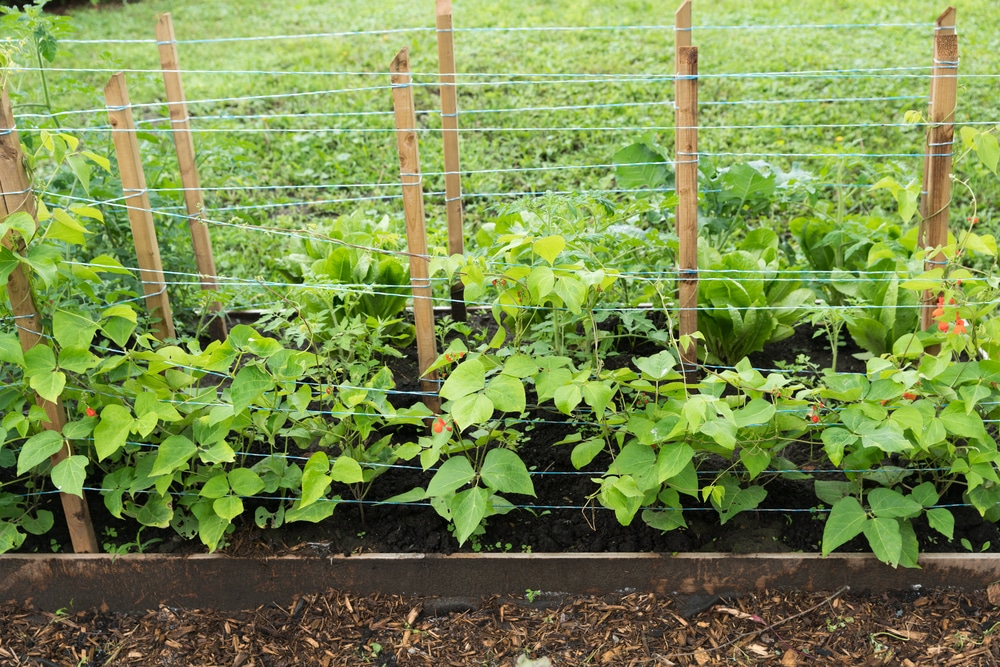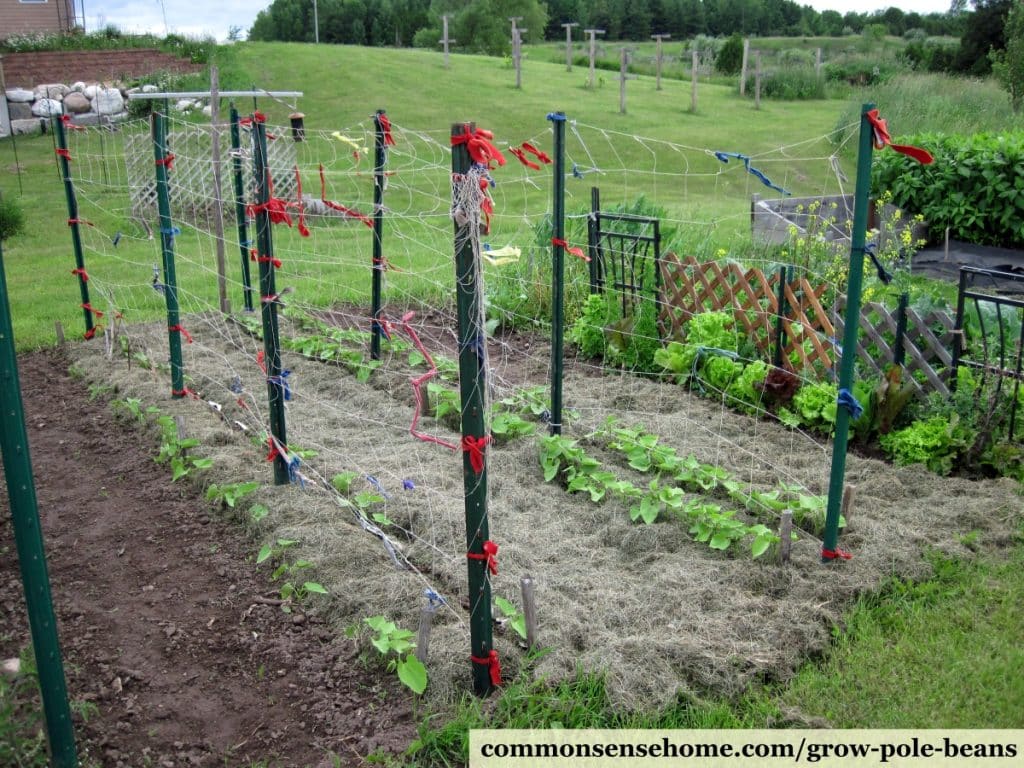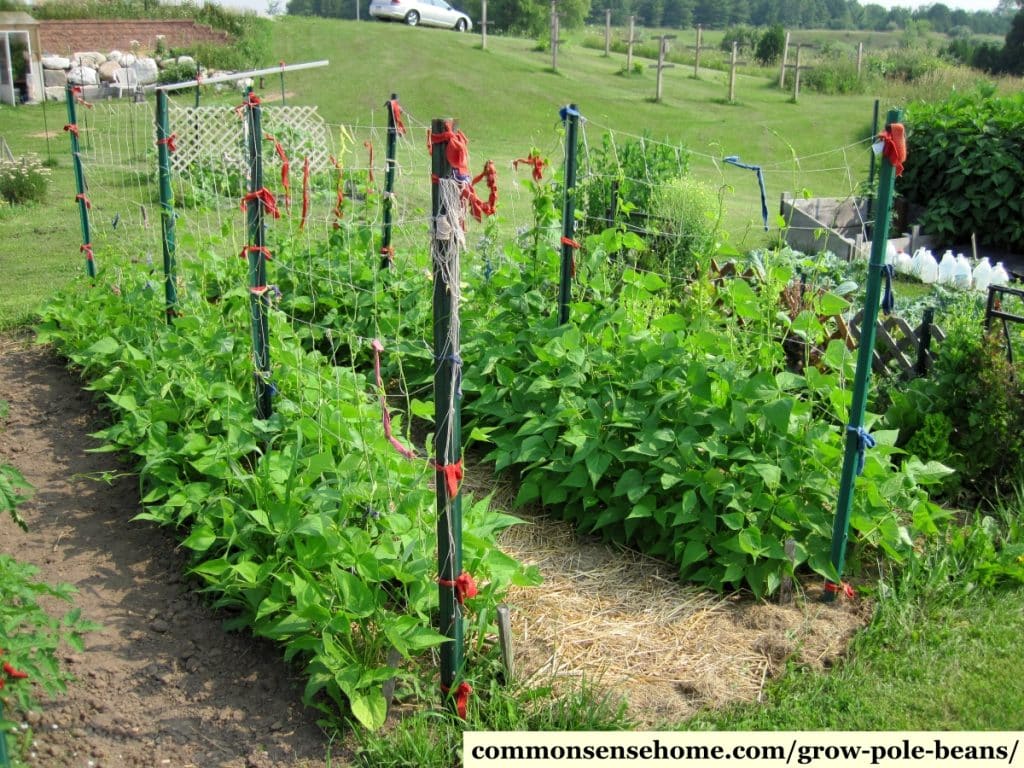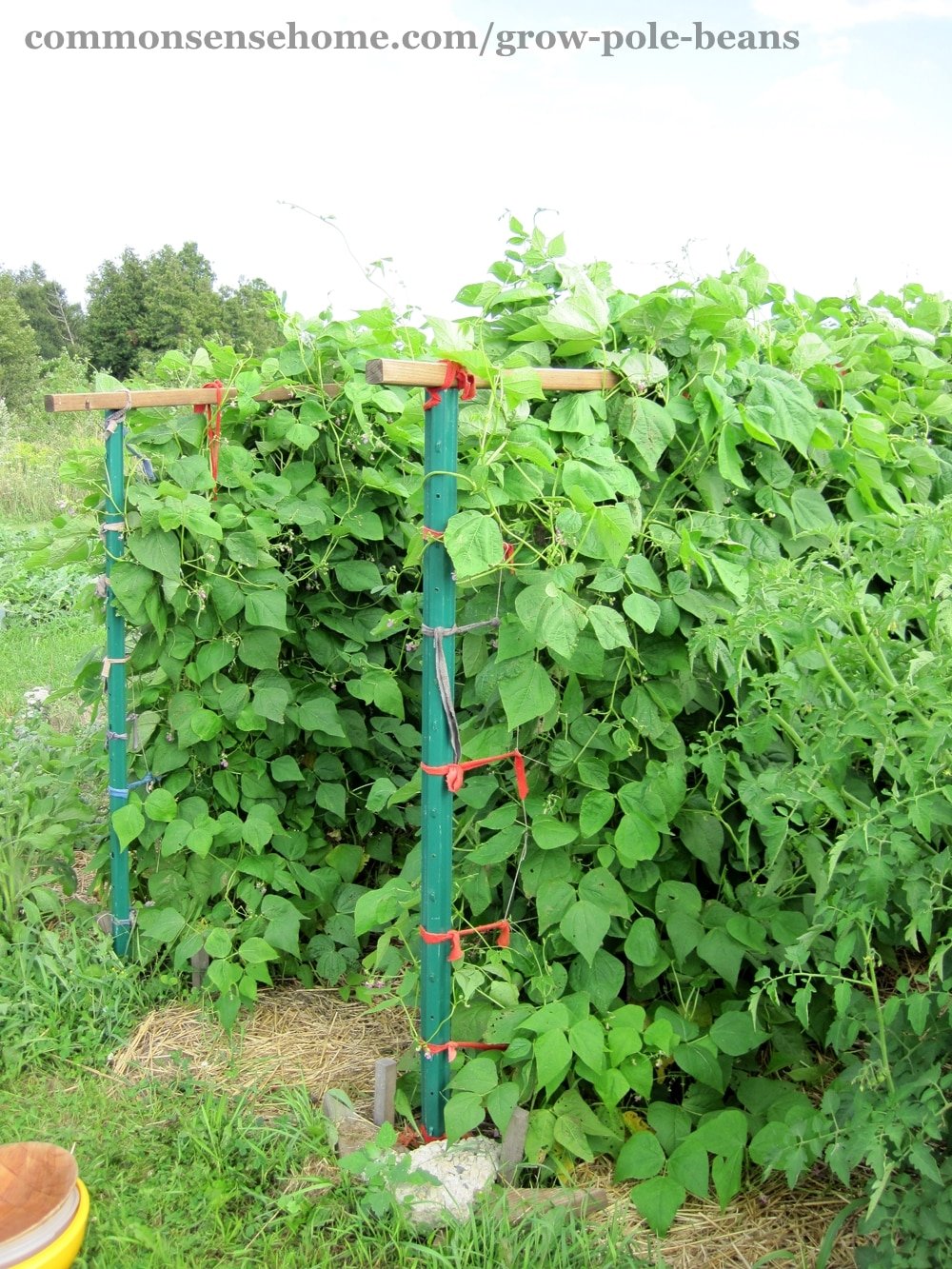Pole beans are one of our favorite vegetables. We share how to grow pole beans, our easy trellis system, favorite varieties, companion plants, and fertilizing tips.
We grow pole beans for fresh eating and preserving, plus extra to swap with the neighbors. Once the season gets rolling, our vines produce until frost. We also save some beans for seed each year.
Growing green beans on a trellis is a great way to maximize your harvest while taking up minimal space. Trellised green beans are easy to care for save space and make harvesting a breeze. In this article, I’ll walk you through how to trellis green beans in six simple steps.
Why Trellis Green Beans?
There are several benefits to trellising green beans versus letting them grow along the ground:
-
Saves space – Trellising allows you to grow beans vertically, taking up less square footage in your garden.
-
Easy to harvest – Beans growing on a trellis are at waist height or higher, saving your back from bending over endless rows.
-
Improves yields – Vertical growth supports higher pod production. Trellised beans yield up to three times more than bush beans!
-
Prevents disease – Getting beans off the ground improves airflow and reduces moisture decreasing the risk of fungus and rot.
-
Looks neat and tidy – An upright green bean trellis keeps your garden looking organized and attractive.
6 Steps to Trellising Green Beans
Follow these six simple steps for trellising green beans in your vegetable garden:
Step 1: Till the Ground
First, prepare your planting area by tilling the soil to loosen it. Remove any weeds or debris. You can till by hand with a shovel or use a rototiller for larger areas.
Tilling improves drainage and root development. It also incorporates amendments like compost into the soil.
Step 2: Install the Trellis
There are many trellis designs to choose from, but a basic A-frame trellis is easy to make and works well for green beans.
Drive sturdy wooden or metal posts into the ground at each end of the planting bed, spaced about 4-6 feet apart. Tie twine, wire, or nylon netting between the posts to create your trellis. Leave some slack to allow it to sag once beans start growing.
Step 3: Plant Green Bean Seeds
You can plant pole or bush bean varieties on a trellis, but pole beans are best suited as they continue climbing as they grow. Popular pole bean types include Blue Lake, Kentucky Wonder, and Scarlet Runner.
Plant seeds 1-2 inches deep and 4-6 inches apart in rows along each side of the trellis. Follow the spacing guidelines on the seed packet.
Step 4: Add Supports
As the beans begin sprouting, add shorter stakes or poles on each side of the trellis row for further support. Tie strips of cloth or twine loosely around the supports and climbing beans, encouraging them to attach and climb up.
You can also weave string horizontally across the main trellis for the grasping vines to cling to.
Step 5: Water and Mulch
Water bean seeds regularly with about an inch of water per week. Add 2-3 inches of mulch around plants to retain moisture and reduce weeds. Organic mulch options include wood chips, grass clippings, straw, or shredded leaves.
Consistent watering is key while plants are establishing and once beans start developing.
Step 6: Harvest Beans
Once green beans reach your desired size, pick by snapping them off the vine. Harvest a few beans from each plant every 1-2 days to encourage continuous pod production.
Use clippers or scissors for easier harvesting and to avoid uprooting the entire plant. Keep beans picked before pods bulge and seeds mature.
Continue caring for plants and enjoy the bounty for up to 2 months! At the end of season, pull up finished plants by the roots and dispose of debris.
Pole Bean Trellis Ideas
Beyond a basic A-frame, there are many creative trellis designs for displaying pole beans:
-
Teepee trellis – Use 5-6 poles lashed together at the top. Beans planted around the base will climb up the teepee.
-
Wattle fencing – Weave flexible branches in a zig-zag between posts. Pole beans love grasping these thin supports.
-
Double row trellis – Support two rows of green beans by running trellis netting between poles on both sides of the bed.
-
DIY obelisk – Construct a tall obelisk trellis from scrap wood and grow beans up all four sides.
-
Decorative supports – Incorporate found objects like birdbaths, arbors, or furniture frames. Beans will cover them with greenery.
-
Cattle panel trellis – Secure a metal cattle panel to posts for instant trellising. Sturdy for heavy vine growth.
Caring for Trellised Green Beans
Follow these tips to keep trellised green beans healthy and productive all season:
-
Water 1-2 inches per week. Increase water during flowering and pod set.
-
Side dress with a nitrogen fertilizer when plants start climbing. This fuels vigorous vine growth.
-
Mulch around plants to conserve moisture and block weeds. Replenish as needed.
-
Prune away overgrown vines or leaves shading bean pods. This improves air circulation.
-
Harvest frequently, at least every 3-4 days. Pick before pods bulge with maturing beans.
-
Monitor for pests like bean beetles or aphids. Use organic methods like insecticidal soap.
-
Remove and dispose finished plants promptly. This prevents disease issues.
Enjoy an Abundant Trellised Green Bean Harvest
Frequency of Entities:
Step 1: 3
Step 2: 2
Step 3: 2
Step 4: 2
Step 5: 3
Step 6: 3
Trellis: 13
Green Beans: 21
Seeds: 3
Water: 3
Harvest: 5
Pods: 4

What’s the Best Pole Bean Trellis?
I’ve seen a lot of creative and beautiful trellises made for pole beans or out of things that people had on hand. Some bean trellis options include:
- Nylon trellis netting – our favorite
- Pole beans can be used to make a nice seasonal privacy screen out of wire fencing.
- Pallets and cattle panels—These are being used as tomato trellises, but they can also be used for beans.
- To support a bean, line up sticks or bamboo poles in a row or make a tepee out of them.
- String trellis: String trellises are usually tied together at the top and bottom to make a tepee shape. Beans may require some encouragement to climb the strings. And if you use biodegradable string, you can throw them away with your bean stalks when the season is over.
- In an arbor, you don’t have to grow just flowers or grapes. You can also grow bean blossoms, which are pretty and tasty.
- The folding metal trellis VineSpineTM—these metal grids can be stored flat.
Whatever bean trellis you choose, make sure it is well-secured so it doesn’t tip over in strong winds. The neighbor’s lost their bean tepee in a storm, just when the beans were starting to mature. It was a big mess, and the beans never fully recovered.
We use nylon trellis netting supported with metal fence posts and wooden cross pieces on top.
- Wide openings are easy to reach through for harvesting. You don’t have to try to reach inside a pyramid trellis to pick fruit; you can do it from both sides.
- Strong: My trellis has been around for many years, except for the time I accidentally cut it with clippers. You might see some of the patches in the photos. Most of my netting is over 5 years old.
- They store in a small amount of space. The nets can be put in a small bag, and the support posts can be stacked in a greenhouse corner.
Place 6- 7 foot tall metal fence posts at five foot intervals along the row. Secure trellis netting to each post in at least four spots. I use strips of old sweatpants for this. You could use twine or whatever you have on hand.
To make weeding easy, we place wet newspaper between the double rows and cover it with mulch. Then we hang the trellis above the mulch. Make sure to get the trellis up while the beans are still small so they don’t get tangled.


I put beans on both sides of the trellis, so as the season goes on, it gets pretty heavy. An old wooden cross is tied to the top of the fence posts to help the bean plants stand up. I use 2″x2″ or 1″x2″ pieces around 6 feet long. We tether the trellis netting to it at regular intervals.
The beans should shoot right up the trellis without much fuss. Once in a while you may need to guide them in the right direction.

Pole Bean Companion Plants
For pole beans, plants that grow well with them include corn, cucumbers, eggplants, marigolds, peas, potatoes, rosemary, and strawberries.
If you want to grow pole beans near basil, beets, cabbage, fennel, kohlrabi, onion family plants, radish, or sunflower, don’t.
I regularly have sunflowers near my pole beans and haven’t seen any problems with it. Sometimes the beans climb right up the sunflowers. Radish and beans are both often eaten by flea beetles, so I can see why it would make sense to keep them separate.

Easy garden vegetable support. Green Bean Trellis Easy and Quick
FAQ
What can I use for a trellis for green beans?
How tall should a trellis be for green beans?
What is the best support for green beans?
